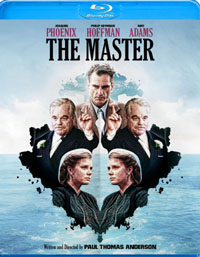 THE MASTER
THE MASTERBlu-ray Review
(R)
MOVIE: ***1/2 (out of 5)
BLU-RAY EXPERIENCE: ***1/2 (out of 5)
STARRING
Joaquin Phoenix as FREDDIE QUELL
Philip Seymour Hoffman as LANCASTER DODD
Amy Adams as PEGGY DODD
Ambyr Childers as ELIZABETH
Jesse Plemons as VAL DODD
Rami Malek as CLARK
Laura Dern as HELEN SULLIVAN
Studio: The Weinstein Company and Anchor Bay
Directed by: Paul Thomas Anderson
BY KEVIN CARR
Last fall, when “The Master” was first making it’s limited run around the country, it was impossible to escape the buzz. Paul Thomas Anderson had become a real darling of the arthouse crowd early in his career, but it wasn’t until he made his Oscar-nominated film “There Will Be Blood” that he reached icon status among serious cinemaphiles.
This respect help build interest in his latest movie, “The Master,” as he personally toured the country with a 70mm print of the film.
I wasn’t lucky enough to see one of those screenings. Instead, I got a local press screening at the one theater that offered (at least then) the worst projection experience in town. So all the beauty and grandeur of “The Master” – from the opening shot of the swirling ocean surface to the rich and warm scenes in the home of the burgeoning cult – was almost completely lost.
Watching the film again on Blu-ray, with a decent flat screen high definition television, was a very different experience indeed.
To talk about “The Master” as a traditional narrative feature does it a disservice. Sure, it can be categorized as a character study of a wayward man who leaves military service and finds a home in a cult. However, that’s not really what the movie is about. Instead, it is an unlikely platonic love story between a mentor and a protege who have no business being such close friends.
Freddie Quell (Joaquin Phoenix) leaves the Navy after World War II, a sexual deviant and a drunk. He has severe problems socializing in the normal world, and stumbles from job to job until he finds himself on a ship with a charismatic cult leader named (Philip Seymour Hoffman). Quell soon becomes duty-bound to his Master, acting as enforcer and devoted follower. However, soon their relationship faces problems as Freddie’s odd social quirks come to odds with the Master’s shifting focus in the development of his own private religion.
More than anything, “The Master” is an acting spotlight for both Phoenix and Hoffman, as well as several members of the supporting cast, including Amy Adams as the Master’s wife. Phoenix plays the most extreme character, exhibiting some extremely strange qualities but never falling into comedic delivery. He gives an honest portrayal of a disturbed individual, but even in the frenetic behavior, he gives us something to relate to.
“The Master” doesn’t try to tell a story as much as it does deliver an experience, or rather multiple experiences. We feel what it was like to live in the age when the film takes place, on the heels of a world war, where the country and its men coming home struggled to adjust. It also gives an eerie but non-judgmental look at what it is like to live under the control of a questionable cult leader.
Leading up to its release, “The Master” was talked about as “the Scientology movie” because the character of the Master was patterned after Scientology-founder L. Ron Hubbard. However, it’s not as much about the development of a modern (and completely off-the-wall) religion, but rather about the charisma of that leader and his relationships (good and bad) with the people in his life.
Don’t watch “The Master” as you would a regular movie, or it will be a sour experience. Rather, watch it for the performances and the excellent cinematography. And take heart that if you never saw the projected 70mm print, it still looks mighty fine on the Blu-ray.
The package comes with both the Blu-ray and the DVD, which also includes Digital Copy. Special features include 20 minutes of outtakes and additional scenes, which play as a mini-movie in itself, offering snapshot looks at the character’s lives. In a strange way, I found these scene more compelling than the film itself because they enhanced the people in the film with interesting situations rather than focusing on one sole story.
Additional features include and eight-minute short behind-the-scenes featurette, a selection of teasers and trailers, as well as John Huston’s 1946 documentary “Let There Be Light,” which examines the psychological struggle (which would now be diagnosed as PTDS) that many World War II veterans endured.
